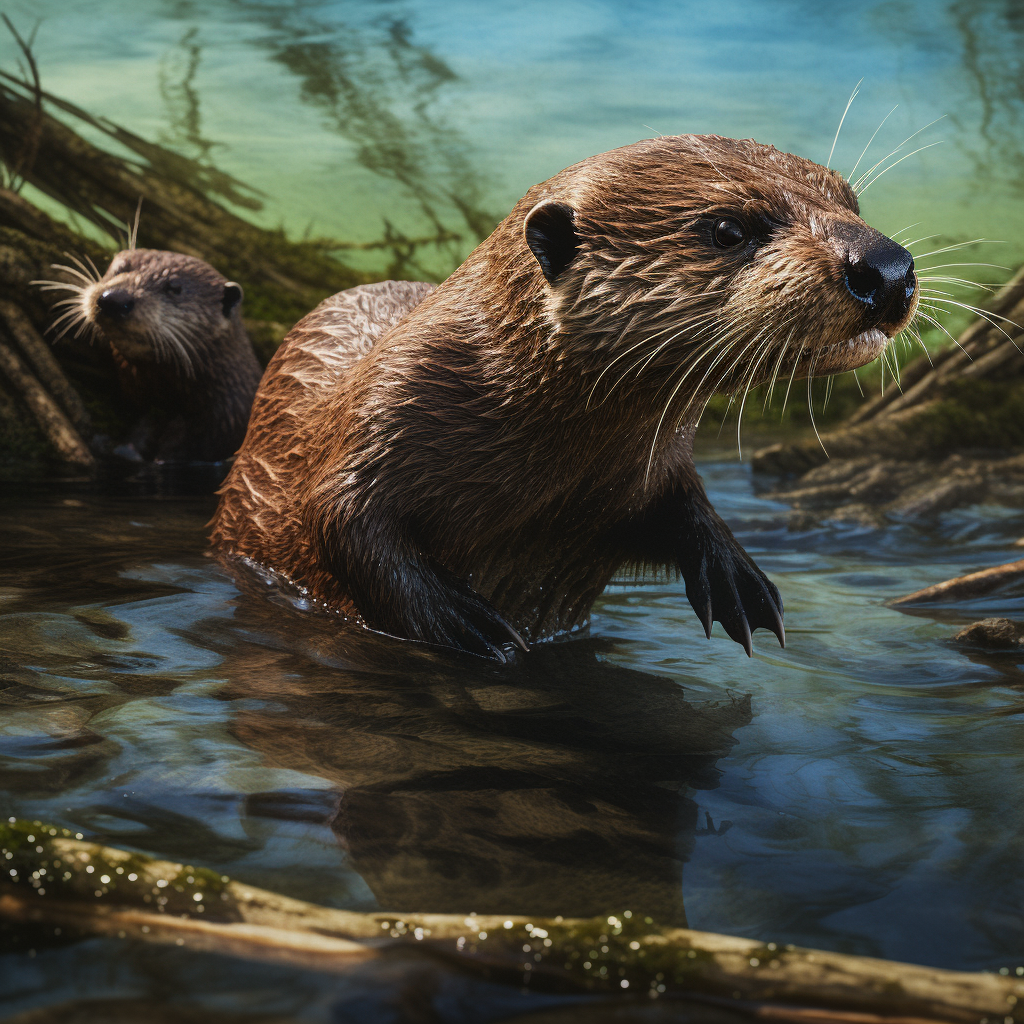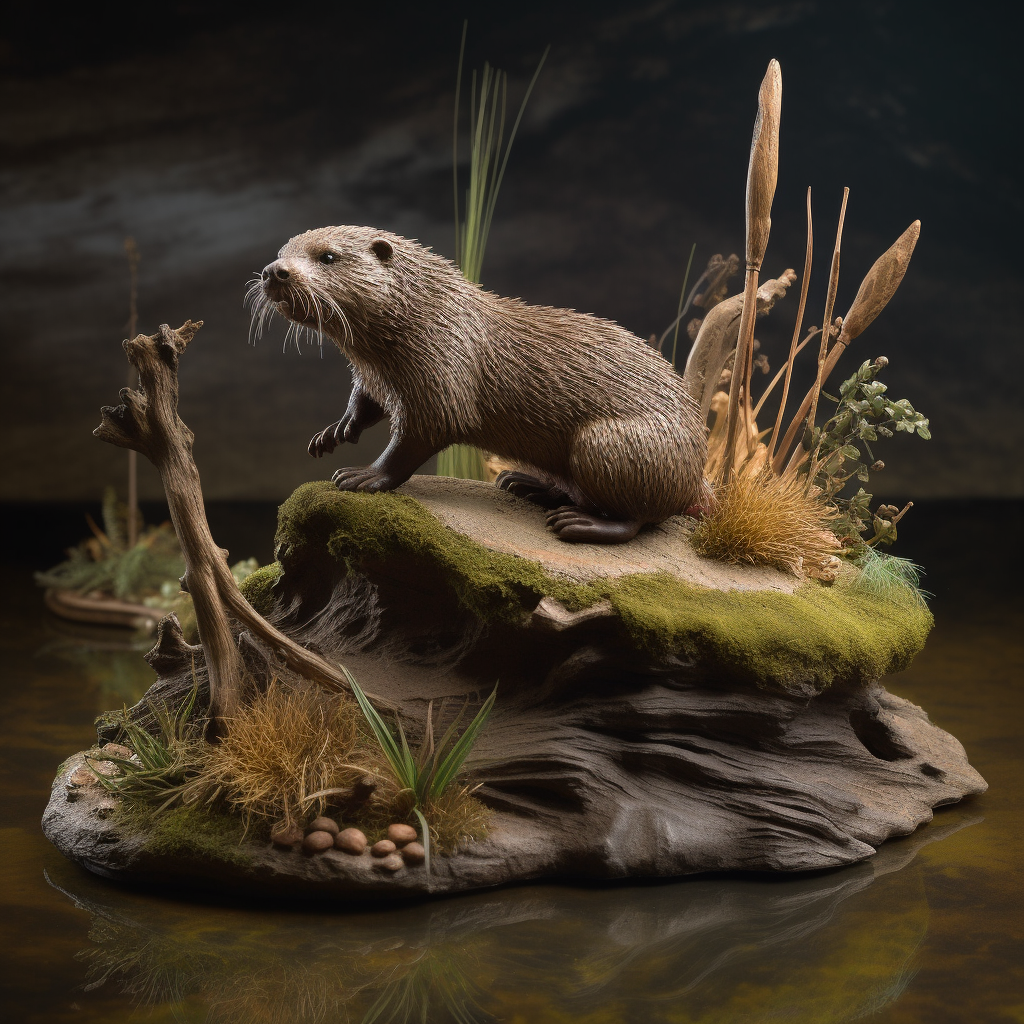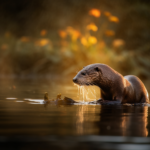The comparison between river otters and muskrats is an intriguing one, as both of these aquatic mammals share similar habitats and characteristics. River otters and muskrats are often found in freshwater environments such as rivers, lakes, and marshes, where they play important roles in the ecosystem. While they may have some similarities, there are also distinct differences between these two animals in terms of their physical appearance, behavior, diet, and overall lifestyle. In this article, we will delve deeper into the world of river otters and muskrats, exploring their unique traits and shedding light on what sets them apart from each other. So, let’s dive in and discover the fascinating world of these two fascinating creatures.
Key Takeaways
- River otters and muskrats are both semi-aquatic mammals found in North America.
- River otters are larger and more agile swimmers compared to muskrats.
- Muskrats are known for their ability to build lodges and burrows in wetland habitats.
- River otters have a varied diet, including fish, amphibians, and small mammals, while muskrats primarily eat aquatic plants.
- Both species play important roles in their ecosystems, but river otters are more adaptable and can thrive in a wider range of habitats.
Understanding River Otters and Muskrats: An Overview
A. What is a River Otter?
River otters are fascinating aquatic mammals that belong to the Mustelidae family, which also includes weasels, badgers, and minks. These sleek and playful creatures are well-adapted to life in and around water, making them excellent swimmers. River otters have long, streamlined bodies, webbed feet, and a thick, water-repellent coat that helps them navigate through rivers, lakes, and wetlands with ease.
River Otter Characteristics
- Streamlined body shape
- Webbed feet for efficient swimming
- Thick, water-repellent fur
- Long, muscular tail for balance
- Sharp claws for catching prey
B. What is a Muskrat?
Muskrats, on the other hand, are semi-aquatic rodents that are native to North America. Despite their name, muskrats are not actually rats but are more closely related to voles and lemmings. These small mammals have round bodies, short legs, and a long, scaly tail. Muskrats are well-adapted to life in wetland habitats, where they build dome-shaped lodges made of vegetation and mud.
Muskrat Features
- Round body shape
- Short legs
- Long, scaly tail
- Small, rounded ears
- Thick, waterproof fur
Both river otters and muskrats are well-suited to their aquatic lifestyles, but they have distinct differences in their appearance, behavior, and habitat preferences. Let’s explore these differences further in the following sections.
Physical Differences: River Otter vs Muskrat
A. Size and Body Structure
When comparing the physical characteristics of river otters and muskrats, one of the first noticeable differences is their size and body structure.
River Otter: – River otters are larger in size compared to muskrats. – They have a long and streamlined body, which is well-adapted for swimming and diving. – Adult river otters can reach lengths of up to 3 to 4 feet, excluding their tail, and weigh between 10 to 30 pounds. – Their body is muscular and elongated, allowing them to move swiftly through the water.
Muskrat: – Muskrats, on the other hand, are smaller in size. – They have a stocky and compact body, which is better suited for their semi-aquatic lifestyle. – Adult muskrats typically measure around 1 to 2 feet in length, excluding their tail, and weigh between 2 to 4 pounds. – Their body is more rounded and less streamlined compared to river otters.
B. Fur and Coloration
Another noticeable difference between river otters and muskrats lies in their fur and coloration.
River Otter: – River otters have dense, waterproof fur that helps insulate them in cold water. – Their fur is dark brown on the upper parts of their body, gradually fading to a lighter shade on their belly. – This coloration provides excellent camouflage in their natural habitat.
Muskrat: – Muskrats also have dense fur, but it is not as waterproof as that of river otters. – Their fur is typically dark brown, with a lighter-colored belly. – The coloration of their fur helps them blend in with the vegetation and marshy areas where they live.
C. Tail and Feet Characteristics
The tail and feet of river otters and muskrats also differ in terms of their characteristics.
River Otter: – River otters have a long, muscular tail that acts as a rudder while swimming. – Their tail is thick at the base and tapers towards the end, providing them with excellent maneuverability in the water. – Their feet are webbed, which allows them to swim efficiently and navigate through rivers, lakes, and other aquatic habitats.
Muskrat: – Muskrats have a flattened, scaly tail that serves as a propeller while swimming. – Their tail is vertically flattened, which helps them move through the water with ease. – Their feet are also partially webbed, enabling them to paddle and propel themselves through the water.
In summary, river otters and muskrats have distinct physical differences. River otters are larger in size, have a more streamlined body, and possess webbed feet for efficient swimming. Muskrats, on the other hand, are smaller, have a stockier body, and possess a vertically flattened tail. These physical adaptations allow each species to thrive in their respective habitats and fulfill their unique ecological roles.
Habitat: Where do River Otters and Muskrats Live?
A. River Otter Habitats
River otters are semi-aquatic mammals that can be found in a variety of habitats across North America. They are well-adapted to both freshwater and marine environments, making them versatile and adaptable creatures. Here are some of the habitats where river otters are commonly found:
-
Rivers and Streams: River otters are often associated with flowing water bodies such as rivers and streams. These habitats provide them with a steady supply of fish, their primary food source. The otters build their dens along the banks of these waterways, creating cozy homes for themselves and their young.
-
Lakes and Ponds: River otters also inhabit lakes and ponds, especially those with abundant vegetation and fish populations. These habitats offer a diverse range of food sources and provide the otters with ample opportunities for swimming and playing.
-
Wetlands and Marshes: Wetlands and marshes are another favored habitat of river otters. These areas are rich in aquatic vegetation, which attracts a variety of fish and invertebrates. The otters navigate through the dense vegetation, using it as cover while hunting for food.
-
Coastal Areas: River otters are known to venture into coastal areas, including estuaries and saltwater marshes. They are excellent swimmers and can adapt to the challenges of living in marine environments. Coastal habitats provide them with access to a different range of prey, such as crabs, clams, and other marine creatures.
B. Muskrat Habitats
Muskrats are also semi-aquatic mammals that inhabit various wetland habitats across North America. They are well-suited to living in marshes, swamps, and other aquatic environments. Here are some of the habitats where muskrats can be found:
-
Marshes and Swamps: Muskrats are particularly fond of marshes and swamps, where they construct their lodges. These habitats are characterized by abundant vegetation, including cattails and other aquatic plants, which provide the muskrats with both food and building materials.
-
Ponds and Lakes: Muskrats can also be found in ponds and lakes, especially those with dense vegetation along the shorelines. These habitats offer the muskrats protection from predators and a diverse range of food sources, including aquatic plants, roots, and tubers.
-
Slow-moving Rivers and Streams: Muskrats are well-adapted to slow-moving rivers and streams, where they build their burrows in the banks. These habitats provide them with access to both land and water, allowing them to forage for food and escape from potential threats.
-
Ditches and Canals: Muskrats are known to inhabit man-made waterways such as ditches and canals. These habitats provide them with a constant water supply and ample vegetation for food and shelter.
In summary, while river otters prefer a wider range of habitats, including rivers, lakes, wetlands, and coastal areas, muskrats are more commonly found in marshes, swamps, ponds, and slow-moving rivers. Both species have adapted to their respective habitats, utilizing the available resources to thrive in their environments.
Behavioural Traits: River Otter and Muskrat

A. Social Behaviour of River Otters
River otters are highly social animals that live in family groups known as “rafts.” These rafts typically consist of a female otter, her offspring, and sometimes a male otter. River otters are known for their playful and energetic nature, often engaging in activities such as sliding down muddy banks or chasing each other in the water.
One of the most fascinating aspects of river otter social behavior is their use of vocalizations to communicate with each other. They produce a variety of sounds, including chirps, whistles, and growls, to convey messages and maintain contact within the group. These vocalizations are crucial for coordinating activities such as hunting and defending their territory.
River otters also exhibit cooperative hunting behavior. They work together to corral fish into shallow areas or use their sharp claws to dig burrows and catch prey hiding underground. This cooperative hunting strategy allows them to maximize their chances of success and secure a sufficient food supply for the entire group.
B. Social Behaviour of Muskrats
Unlike river otters, muskrats are generally solitary animals. They establish territories and defend them vigorously against intruders. Male muskrats are particularly territorial and will engage in aggressive fights to protect their space. They mark their territories with scent glands located near their tails, leaving a strong odor that acts as a warning to other muskrats.
Muskrats are also known for their impressive engineering skills. They build dome-shaped lodges using vegetation, mud, and sticks. These lodges serve as their homes and provide protection from predators. Muskrats are excellent swimmers and use their powerful tails to propel themselves through the water, making them well-adapted to their semi-aquatic lifestyle.
C. Feeding Habits: What do River Otters and Muskrats Eat?
River otters and muskrats have different feeding habits due to their distinct anatomical features and dietary preferences.
River otters primarily feed on fish, amphibians, crustaceans, and small mammals. They are skilled hunters and use their sharp teeth and strong jaws to catch and consume their prey. River otters are also known to eat birds, reptiles, and even insects when other food sources are scarce. Their diet is primarily composed of aquatic organisms, as they spend a significant amount of time in the water.
On the other hand, muskrats are herbivores and mainly consume aquatic plants such as cattails, water lilies, and pondweed. They have specialized adaptations that allow them to efficiently extract nutrients from plant material. Muskrats are able to close off their nostrils and lips, enabling them to chew and swallow underwater. This adaptation allows them to feed on plants that grow in aquatic environments.
In summary, while river otters are social animals that engage in cooperative hunting and communicate through vocalizations, muskrats are solitary creatures that mark their territories and construct lodges. Additionally, river otters have a diverse diet consisting of fish and other aquatic organisms, while muskrats primarily feed on aquatic plants. These behavioral and dietary differences highlight the unique adaptations of these two fascinating creatures.
Reproduction and Lifespan: River Otter vs Muskrat
A. River Otter Reproduction and Lifespan
River otters have fascinating reproductive behaviors and relatively long lifespans. These playful creatures typically reach sexual maturity between the ages of two and three. Once they are ready to mate, river otters engage in a courtship ritual that involves chasing, wrestling, and vocalizing.
Female river otters give birth to their young, known as pups, in underground burrows called holts. The gestation period lasts for about two months, after which a litter of one to six pups is born. The mother otter diligently cares for her pups, nursing them and teaching them essential survival skills.
The lifespan of a river otter can vary depending on various factors such as habitat, food availability, and predation. In the wild, river otters can live up to 10 to 15 years, although some individuals have been known to live even longer. In captivity, where they are protected from natural predators and have access to a consistent food supply, river otters can live up to 25 years.
B. Muskrat Reproduction and Lifespan
Muskrats, like river otters, have interesting reproductive behaviors and relatively short lifespans compared to their larger counterparts. Muskrats reach sexual maturity at around one year of age. They are known for their polygamous mating system, where males mate with multiple females during the breeding season.
Female muskrats construct dome-shaped nests, known as lodges, made from vegetation and mud. These lodges are built in marshes or along the banks of rivers and provide a safe haven for the muskrat family. The gestation period for muskrats lasts around one month, and a litter of four to eight young, called kits, is born.
Muskrats have a relatively short lifespan compared to river otters. In the wild, muskrats typically live for about three to four years. However, in captivity, where they are protected from predators and have access to a consistent food supply, muskrats can live up to eight years.
In summary, both river otters and muskrats have unique reproductive behaviors and lifespans. River otters have a longer lifespan, with individuals living up to 10 to 15 years in the wild and even longer in captivity. Muskrats, on the other hand, have a shorter lifespan, typically living for about three to four years in the wild and up to eight years in captivity.
Conservation Status: River Otters and Muskrats

A. Threats to River Otters
River otters (Lontra canadensis) are semi-aquatic mammals that inhabit freshwater ecosystems across North America. While they were once on the brink of extinction due to habitat loss and overhunting, their conservation status has improved over the years. However, river otters still face several threats that require ongoing conservation efforts.
-
Habitat Loss: One of the primary threats to river otters is the loss and degradation of their natural habitats. Human activities such as urbanization, deforestation, and the construction of dams can disrupt their aquatic ecosystems, leading to a decline in their population.
-
Water Pollution: River otters are highly sensitive to water pollution. Industrial waste, agricultural runoff, and chemical contaminants can contaminate their habitats, affecting their health and reproductive success. Additionally, oil spills pose a significant threat to these animals, as their fur can become coated with oil, impairing their ability to stay warm and buoyant.
-
Overfishing: River otters rely on a diverse diet of fish, amphibians, crustaceans, and small mammals. Overfishing can deplete their food sources, leading to malnutrition and population decline. The depletion of fish stocks can also disrupt the balance of aquatic ecosystems, impacting other species as well.
B. Threats to Muskrats
Muskrats (Ondatra zibethicus) are small, semi-aquatic rodents that inhabit wetlands and marshes throughout North America. While they are not currently considered a threatened species, they still face certain threats that can impact their population.
-
Habitat Loss: Similar to river otters, muskrats are vulnerable to habitat loss caused by human activities. Wetland drainage, land development, and the destruction of marshes can reduce the availability of suitable habitats for muskrats, leading to population decline.
-
Predation: Muskrats have several natural predators, including foxes, coyotes, birds of prey, and large snakes. Increased predation pressure can impact muskrat populations, especially in areas where predator populations are high.
-
Disease and Parasites: Muskrats are susceptible to various diseases and parasites, including tularemia, leptospirosis, and fleas. Outbreaks of these diseases can have a significant impact on muskrat populations, especially in dense populations or areas with poor water quality.
C. Conservation Efforts
Conservation efforts are crucial to ensuring the survival and well-being of both river otters and muskrats. Several organizations and initiatives are actively working towards protecting these species and their habitats.
-
Habitat Conservation: Protecting and restoring the natural habitats of river otters and muskrats is essential for their long-term survival. This includes preserving wetlands, maintaining water quality, and implementing measures to reduce habitat fragmentation.
-
Legislation and Regulation: Laws and regulations play a vital role in conserving river otters and muskrats. The enforcement of hunting and trapping regulations, as well as the designation of protected areas, helps prevent overexploitation and provides a safe haven for these animals.
-
Education and Awareness: Educating the public about the importance of river otters and muskrats in ecosystems can foster a sense of stewardship and encourage conservation efforts. Awareness campaigns, educational programs, and community involvement can all contribute to the conservation of these species.
In conclusion, while river otters and muskrats face different threats, their conservation status relies on similar efforts. By addressing habitat loss, pollution, overfishing, predation, and disease, we can ensure the long-term survival of these fascinating and ecologically important animals. It is our responsibility to protect and preserve their habitats, allowing future generations to appreciate the beauty and significance of river otters and muskrats in our natural world.
River Otter or Muskrat: Identifying Them in the Wild

A. Key Identifying Features of River Otters
River otters and muskrats are both fascinating creatures that can be found in various aquatic habitats. While they may share some similarities, they also possess distinct characteristics that set them apart. Let’s take a closer look at the key identifying features of river otters.
-
Size and Appearance: River otters are larger than muskrats, measuring around 3 to 4 feet in length, including their tail. They have a sleek and streamlined body, covered in dense, waterproof fur. Their fur can range in color from dark brown to almost black, with a lighter underbelly.
-
Head and Face: River otters have a relatively large head with small, rounded ears. Their face is characterized by a blunt snout and a pair of dark, intelligent eyes. They also possess long, sensitive whiskers that aid in navigation and hunting underwater.
-
Tail: One of the most distinctive features of river otters is their long, muscular tail. Their tail is thick at the base and tapers towards the end, resembling a paddle. This tail helps them with balance and propulsion while swimming.
-
Webbed Feet: River otters have fully webbed feet, which enable them to be excellent swimmers. Their webbed feet act like flippers, allowing them to maneuver swiftly through the water with ease. On land, they can retract their webbing to reveal sharp claws for digging and climbing.
-
Behavior: River otters are highly active and playful animals. They are known for their acrobatic swimming skills and can often be seen diving, rolling, and sliding in the water. They are also social creatures, living in family groups called “rafts” and communicating through various vocalizations.
B. Key Identifying Features of Muskrats
Now, let’s turn our attention to the key identifying features of muskrats, another fascinating aquatic mammal.
-
Size and Appearance: Muskrats are smaller than river otters, measuring around 1 to 2 feet in length, excluding their tail. They have a stocky body covered in thick, dark brown fur. Unlike river otters, muskrats have a flattened, rat-like tail that is scaly rather than furred.
-
Head and Face: Muskrats have a small, rounded head with small ears that are often not visible. Their face is characterized by a pointed snout and small, black eyes. They also possess short whiskers that aid in detecting vibrations in the water.
-
Tail: As mentioned earlier, the tail of a muskrat is flattened vertically, resembling a paddle. This unique tail adaptation allows them to swim efficiently through the water. Muskrats also use their tail as a prop when sitting upright on land or while constructing their lodges.
-
Feet: Muskrats have partially webbed feet, with each toe being individually webbed. This partial webbing enables them to navigate through the water and move across marshy habitats. On land, their feet are adapted for digging burrows and constructing their homes.
-
Behavior: Muskrats are primarily nocturnal creatures, meaning they are most active during the night. They are excellent swimmers and can stay submerged for up to 15 minutes. Muskrats are also known for their ability to construct lodges made of vegetation, which provide them with shelter and protection.
In conclusion, while river otters and muskrats may share some similarities, such as their aquatic habitats and swimming abilities, they can be easily distinguished by their size, appearance, and unique adaptations. River otters are larger, have fully webbed feet, and possess a long, muscular tail. On the other hand, muskrats are smaller, have partially webbed feet, and possess a flattened, scaly tail. Understanding these key identifying features can help nature enthusiasts and wildlife observers differentiate between these two remarkable animals in the wild. Conclusion
In conclusion, both the river otter and the muskrat are fascinating creatures that inhabit freshwater environments. While they share some similarities, such as their semi-aquatic nature and their ability to swim and dive, they also have distinct differences in terms of their physical characteristics, behavior, and ecological roles. The river otter is larger in size and has a sleek, streamlined body that allows it to move swiftly through the water. It is a skilled predator, feeding on a variety of fish, amphibians, and invertebrates. On the other hand, the muskrat is smaller and has a stockier build, with adaptations that enable it to thrive in marshy habitats. It primarily feeds on aquatic vegetation and constructs intricate lodges for shelter. While both species play important roles in their respective ecosystems, the river otter has faced significant population declines in the past due to habitat loss and pollution, whereas the muskrat has been able to adapt and maintain stable populations. Overall, studying and understanding these two species not only provides insights into their unique characteristics but also highlights the importance of conservation efforts to ensure the survival of these remarkable creatures for future generations.
Frequently Asked Questions
1. What is the difference between an otter and a muskrat?
The main differences between a river otter and a muskrat lie in their physical characteristics, behavior, and habitats. River otters are larger, have a more streamlined body for swimming, and a rounded, muscular tail. Muskrats, on the other hand, are smaller with a more compact body and a flat, scaly tail. In terms of behavior, otters are more playful and social, while muskrats are more solitary. Otters prefer living in water bodies with a strong current, whereas muskrats can often be found in still waters.
2. How do river otter and muskrat habitats differ?
River otters typically inhabit environments with a strong current such as rivers, streams, and the coastlines of lakes and oceans. They require a water body within their home range that includes a food source and bankside vegetation. Muskrats, on the other hand, prefer still or slow-moving water bodies like marshes, beaver ponds, and slow-moving streams. They build lodges or burrows in the banks of these water bodies.
3. What do river otters and muskrats eat?
River otters are carnivorous and their diet mainly consists of fish, but they also eat amphibians, crustaceans, and occasionally small mammals and birds. Muskrats are omnivores, but their diet primarily consists of aquatic vegetation. They also eat small aquatic animals, such as frogs, crayfish, and clams.
4. How do river otter and muskrat behaviors differ?
River otters are known for their playful behavior, which includes sliding down riverbanks and engaging in games with other otters. They are also nocturnal and more social than muskrats. Muskrats, on the other hand, are mostly active at night and are generally solitary creatures. They spend much of their time feeding and grooming.
5. How do river otters and muskrats compare in size?
River otters are generally larger than muskrats. An adult river otter can measure up to 1.4 meters long and weigh between 5 to 14 kilograms. Muskrats, on the other hand, are smaller, measuring up to 0.6 meters long and weighing between 0.6 to 2 kilograms.
6. What is the lifespan of a river otter compared to a muskrat?
The lifespan of a river otter in the wild ranges from 8 to 9 years, but they can live up to 21 years in captivity. Muskrats have a shorter lifespan, typically living up to 3 to 4 years in the wild.
7. What are the main predators of river otters and muskrats?
The main predators of river otters include bears, wolves, and large birds of prey. For muskrats, their predators include foxes, minks, owls, and large birds of prey.
8. What are some adaptations of river otters and muskrats?
River otters have several adaptations for a semi-aquatic lifestyle, including a streamlined body, webbed feet for swimming, and dense fur for insulation. Muskrats also have adaptations for living in water, such as a flat tail for propulsion, partially webbed hind feet, and the ability to close their ears and nostrils when underwater.
9. How do river otter and muskrat tracks differ?
River otter tracks typically show five toes and claw marks, with a distinct heel pad. The tracks are often found in a bounding pattern. Muskrat tracks, on the other hand, show four toes on the front foot and five on the hind foot, with no visible claw marks. Their tracks are often found in a walking pattern.
10. How do river otter and muskrat fur differ?
River otter fur is dense, short, and waterproof, which helps to insulate them in cold water. It is usually dark brown. Muskrat fur, on the other hand, is also waterproof but is coarser and longer. It is usually a mix of brown and black, with the belly being lighter in color.




